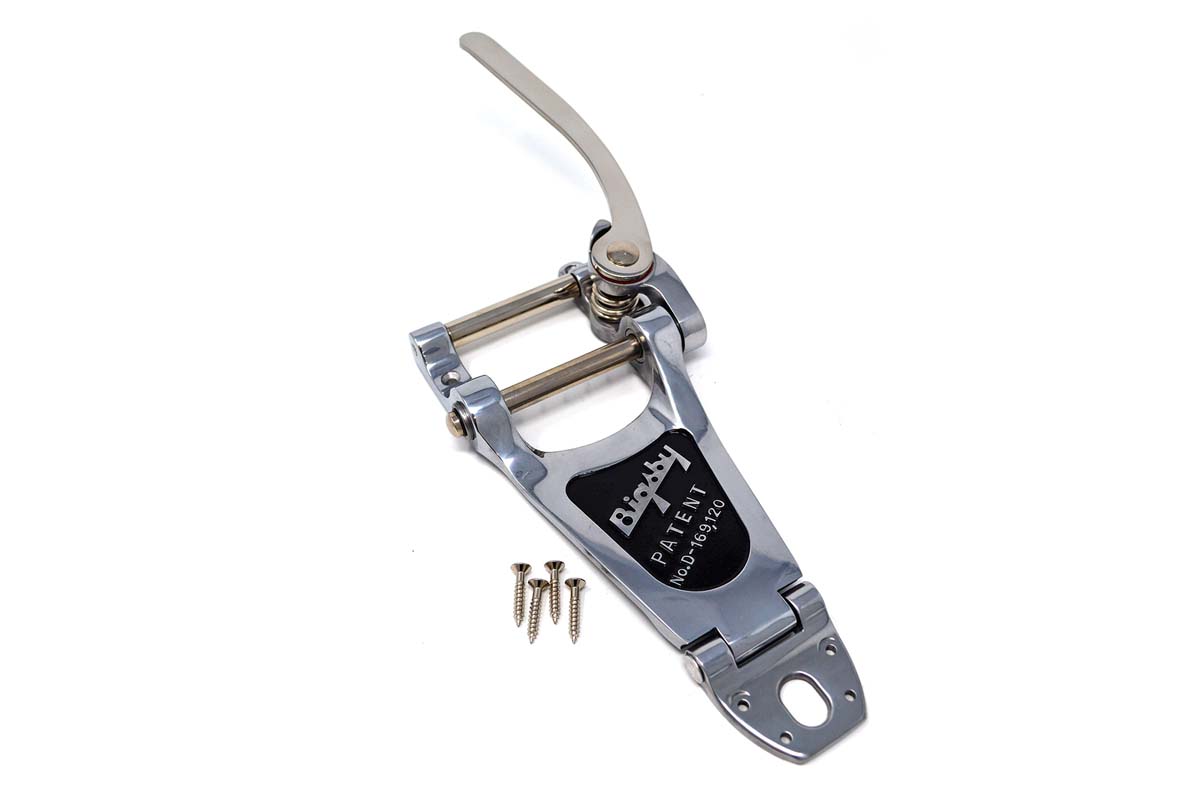Bigsby vibratos: charting the history of the game-changing guitar hardware
Andy Babiuk – musician and author of The Story Of Paul Bigsby: The Father Of The Modern Electric Solid Body Guitar – uncovers the origins of Paul Bigsby’s masterpieces

“If you asked someone, ‘Do you know what a Bigsby is?’ they’ll probably tell you it’s a vibrato,” says Andy. “But they might not be able to tell you it was invented by someone called Paul Bigsby, and that he was the same guy who made the first solidbody electric guitar [for Merle Travis in 1948].
“The very first Bigsby vibrato was also made for Merle [in 1951]. The guitar came first and he was experimenting with pedal steels, so the idea of pulling the strings in and out of tune was kind of natural. When Paul first met Merle, they got to talking about guitars and he told him, ‘I can build anything – I’m a patternmaker.’
“Prior to making instruments, Paul built motorcycles, so for him to tackle a vibrato was relatively easy. As a matter of fact, the vibrato spring was already a part they used on a motorcycle!

“His daughter, Mary Bigsby, told me he’d be asked to do something and that he’d just sit there on paper until he figured out how to do it. Then he’d carve it out of pear wood to exact specifications, make a sandcast and then pour the metal. He didn’t just send the vibrato design off to some place to get it made – he did it himself in his own backyard!”
1. B6

“The first Bigsby True Vibrato was offered with the guitars that Paul custom-built for people such as Merle Travis and Billy Byrd. But then he picks up the phone and calls [Gibson president] Ted McCarty and says, ‘Ted, I’ve got this device. I’ll give you an exclusive on it.’ So they make a deal, and he’s making these vibratos that were only available through Gibson for the first year.
“But then Fred Gretsch in Brooklyn sees it and he calls up Paul Bigsby and says, ‘Hey, we’d like to put these on Gretsch guitars.’ I’ve got an audio tape of Paul Bigsby talking to a friend of his and he’s saying, ‘I’ve got a real dilemma here!’ And that was the famous B6 – the very first one.
“The strings wrap around that single bar and then a separate bridge holds the break angle. I asked Mary why it was called the B6, but she had absolutely no idea. And it’s not documented, either.”
All the latest guitar news, interviews, lessons, reviews, deals and more, direct to your inbox!
2. B16

“The second one – the B16 – was originally made [between 1953 and 1954] specifically for the Fender Telecaster. Paul Bigsby and Leo Fender were close friends. He said, ‘Leo, I’m going to make an accessory you can sell as an aftermarket product for your guitar.’
“You take off the bridge and the Telecaster pickup fits in there with the screw holes. By the time the Stratocaster came out in ’54, however, they’re no longer friends. Paul thought Leo stole his headstock shape, and there’s the Strat vibrato system.
“Mary Bigsby said, ‘My dad came home one night, and he was fuming mad, throwing things around and cussing. They went from close friends and hanging out at each other’s houses all the time to being mortal enemies.’ And that’s why Paul stopped making the B16. They started being made again when Ted McCarty picked up the company [in 1965/’66].”
3. B7

“String tension is very important. Some of the early Bigsby guitars had the vibrato cut into the top in order to get a deep enough break-angle on the strings. The Billy Byrd guitar is like that. So Paul Bigsby came up with a new unit that would compensate: the B7.
“The B7 is similar to the B6 but it comes with an extra roller bar. You roll the strings over the top, so that they go down and then they go back up again to give you the right break angle. Meanwhile, the B5 [often referred to as the ‘horseshoe Bigsby’] is similar, but it’s shorter. It doesn’t tail on the end of the body – it just goes on the face of a flat-topped solidbody.
“The B7 is what would fit on, say, a Les Paul [with an arched top] because of the angle of the body and the position of the neck and the bridge. It’s all about the geometry.”
4. Gretsch

“While Paul Bigsby was supplying Gibson with the B6 – supposedly on an exclusive basis – he made a deal with Fred Gretsch and started making Bigsby vibratos with the Gretsch name on. But Paul Bigsby was such good friends with Ted McCarty he didn’t want to double-cross him, so he told him, ‘I’m going to sell these to Fred Gretsch, but I’m going to upcharge him and give you the difference.’
“When Paul Bigsby decided to retire in 1965, he calls up Ted and says, ‘I’m selling the company. Are you interested?’ Ted asked him, ‘Are you calling me as your friend, or the Gibson president?’ and he said, ‘Your friend.’ So they made a deal and Ted quit Gibson.
“He had the whole thing from that day, and that’s when you get all the other variations of Bigsbys. He had it until 1999 when Gretsch bought it, then a couple of years ago it was purchased by FMIC.”
Rod Brakes is a music journalist with an expertise in guitars. Having spent many years at the coalface as a guitar dealer and tech, Rod's more recent work as a writer covering artists, industry pros and gear includes contributions for leading publications and websites such as Guitarist, Total Guitar, Guitar World, Guitar Player and MusicRadar in addition to specialist music books, blogs and social media. He is also a lifelong musician.

